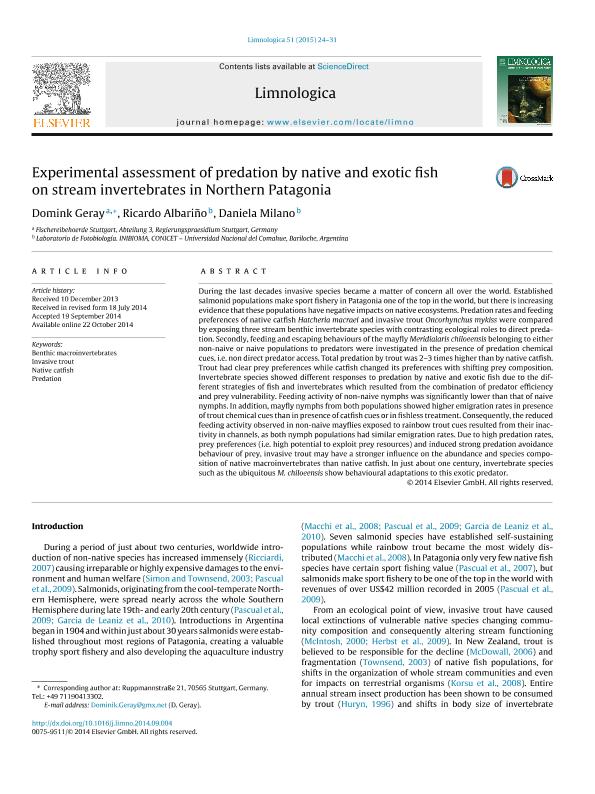Mostrar el registro sencillo del ítem
dc.contributor.author
Dominik, Geray
dc.contributor.author
Albariño, Ricardo Javier

dc.contributor.author
Milano, Daniela

dc.date.available
2018-05-11T18:43:21Z
dc.date.issued
2015-03
dc.identifier.citation
Dominik, Geray; Albariño, Ricardo Javier; Milano, Daniela; Experimental assessment of predation by native and exotic fish on stream invertebrates in Northern Patagonia; Elsevier Gmbh; Limnologica; 51; 1; 3-2015; 24-31
dc.identifier.issn
0075-9511
dc.identifier.uri
http://hdl.handle.net/11336/44948
dc.description.abstract
During the last decades invasive species became a matter of concern all over the world. Established salmonid populations make sport fishery in Patagonia one of the top in the world, but there is increasing evidence that these populations have negative impacts on native ecosystems. Predation rates and feeding preferences of native catfish Hatcheria macraei and invasive trout Oncorhynchus mykiss were compared by exposing three stream benthic invertebrate species with contrasting ecological roles to direct predation. Secondly, feeding and escaping behaviours of the mayfly Meridialaris chiloeensis belonging to either non-naive or naive populations to predators were investigated in the presence of predation chemical cues, i.e. non direct predator access. Total predation by trout was 2-3 times higher than by native catfish. Trout had clear prey preferences while catfish changed its preferences with shifting prey composition. Invertebrate species showed different responses to predation by native and exotic fish due to the different strategies of fish and invertebrates which resulted from the combination of predator efficiency and prey vulnerability. Feeding activity of non-naive nymphs was significantly lower than that of naive nymphs. In addition, mayfly nymphs from both populations showed higher emigration rates in presence of trout chemical cues than in presence of catfish cues or in fishless treatment. Consequently, the reduced feeding activity observed in non-naive mayflies exposed to rainbow trout cues resulted from their inactivity in channels, as both nymph populations had similar emigration rates. Due to high predation rates, prey preferences (i.e. high potential to exploit prey resources) and induced strong predation avoidance behaviour of prey, invasive trout may have a stronger influence on the abundance and species composition of native macroinvertebrates than native catfish. In just about one century, invertebrate species such as the ubiquitous Meridialaris chiloeensis show behavioural adaptations to this exotic predator.
dc.format
application/pdf
dc.language.iso
eng
dc.publisher
Elsevier Gmbh

dc.rights
info:eu-repo/semantics/openAccess
dc.rights.uri
https://creativecommons.org/licenses/by-nc-sa/2.5/ar/
dc.subject
Benthic Macroinvertebrates
dc.subject
Invasive Trout
dc.subject
Native Catfish
dc.subject
Predation
dc.subject.classification
Otras Ciencias Biológicas

dc.subject.classification
Ciencias Biológicas

dc.subject.classification
CIENCIAS NATURALES Y EXACTAS

dc.title
Experimental assessment of predation by native and exotic fish on stream invertebrates in Northern Patagonia
dc.type
info:eu-repo/semantics/article
dc.type
info:ar-repo/semantics/artículo
dc.type
info:eu-repo/semantics/publishedVersion
dc.date.updated
2018-04-09T16:59:19Z
dc.journal.volume
51
dc.journal.number
1
dc.journal.pagination
24-31
dc.journal.pais
Alemania

dc.journal.ciudad
Berlín
dc.description.fil
Fil: Dominik, Geray. Fischereibehoerde Stuttgart; Alemania
dc.description.fil
Fil: Albariño, Ricardo Javier. Consejo Nacional de Investigaciones Científicas y Técnicas. Centro Científico Tecnológico Conicet - Patagonia Norte. Instituto de Investigaciones en Biodiversidad y Medioambiente. Universidad Nacional del Comahue. Centro Regional Universidad Bariloche. Instituto de Investigaciones en Biodiversidad y Medioambiente; Argentina
dc.description.fil
Fil: Milano, Daniela. Consejo Nacional de Investigaciones Científicas y Técnicas. Centro Científico Tecnológico Conicet - Patagonia Norte. Instituto de Investigaciones en Biodiversidad y Medioambiente. Universidad Nacional del Comahue. Centro Regional Universidad Bariloche. Instituto de Investigaciones en Biodiversidad y Medioambiente; Argentina
dc.journal.title
Limnologica

dc.relation.alternativeid
info:eu-repo/semantics/altIdentifier/url/https://www.sciencedirect.com/science/article/pii/S0075951114000619?via%3Dihub
dc.relation.alternativeid
info:eu-repo/semantics/altIdentifier/doi/http://dx.doi.org/10.1016/j.limno.2014.09.004
Archivos asociados
